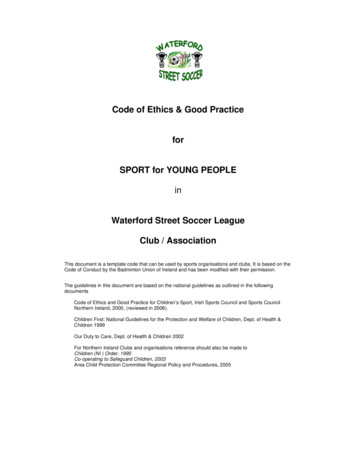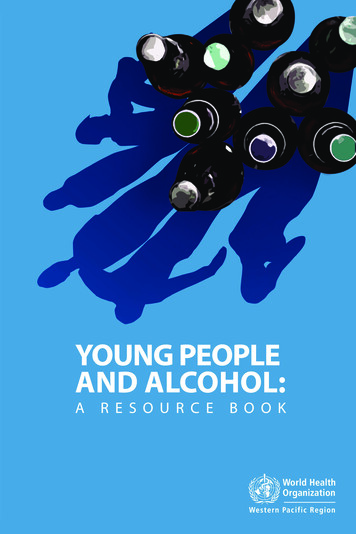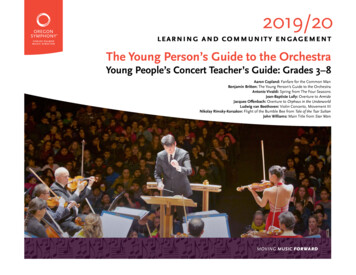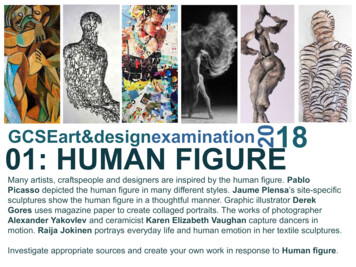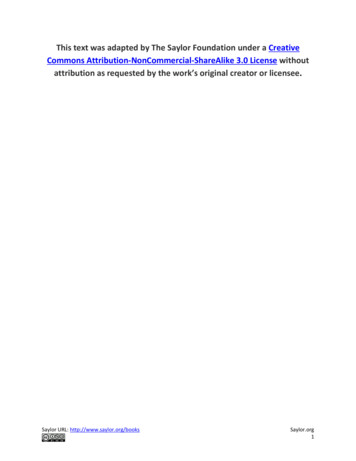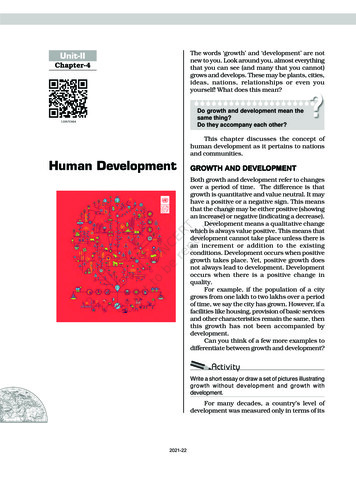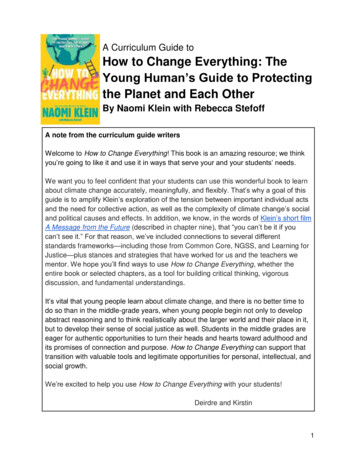
Transcription
A Curriculum Guide toHow to Change Everything: TheYoung Human’s Guide to Protectingthe Planet and Each OtherBy Naomi Klein with Rebecca StefoffA note from the curriculum guide writersWelcome to How to Change Everything! This book is an amazing resource; we thinkyou’re going to like it and use it in ways that serve your and your students’ needs.We want you to feel confident that your students can use this wonderful book to learnabout climate change accurately, meaningfully, and flexibly. That’s why a goal of thisguide is to amplify Klein’s exploration of the tension between important individual actsand the need for collective action, as well as the complexity of climate change’s socialand political causes and effects. In addition, we know, in the words of Klein’s short filmA Message from the Future (described in chapter nine), that “you can’t be it if youcan’t see it.” For that reason, we’ve included connections to several differentstandards frameworks—including those from Common Core, NGSS, and Learning forJustice—plus stances and strategies that have worked for us and the teachers wementor. We hope you’ll find ways to use How to Change Everything, whether theentire book or selected chapters, as a tool for building critical thinking, vigorousdiscussion, and fundamental understandings.It’s vital that young people learn about climate change, and there is no better time todo so than in the middle-grade years, when young people begin not only to developabstract reasoning and to think realistically about the larger world and their place in it,but to develop their sense of social justice as well. Students in the middle grades areeager for authentic opportunities to turn their heads and hearts toward adulthood andits promises of connection and purpose. How to Change Everything can support thattransition with valuable tools and legitimate opportunities for personal, intellectual, andsocial growth.We’re excited to help you use How to Change Everything with your students!Deirdre and Kirstin1
About the BookAdapted from Naomi Klein’s two decades of climate writing, including This ChangesEverything, the book How to Change Everything is both a guide and a toolkit for youngreaders to understand and combat climate change and actually change the world.Written on a foundation of science interwoven with current and historical events andfocused on youth action, this book provides a clear and coherent presentation of theinterconnected environmental and social crises that our young generation faces. It issimultaneously realistic about complex and serious climate issues and hopeful aboutyoung people’s ability to problem-solve the climate crises. How to Change Everything isdivided into three sections. “Part I: Where We Are” introduces readers to kids likethemselves fighting against climate change and for social justice. “Part II: How We GotHere” examines what we have learned about our climate and traces human actionsleading up to the present. “Part III: What Happens Next” is an invitation to youngpeople, offering them opportunities to understand the environmental effects of climatechange while empowering them to take action to temper those effects by fighting withpurpose and hope for climate justice for all people.Discussion QuestionsThe following discussion questions may be used for individual writing prompts or toguide robust classroom discussion, and are broken down into sections following thebook’s structure. In order to deepen understanding and facilitate critical thinking, questions arebalanced among four types: convergent (or closed), divergent (or open),evaluative (or application/synthesis), and rhetorical. These common questiontypes are long established as effective in classroom learning, and balancingamong them offers varied entry points for students so as to welcome everyoneinto the conversation. Questions are also formulated to address Common Core English LanguageArts - Science & Technical Subjects standards, Common Core English LanguageArts Writing standards as well as Learning for Justice standards. Thesealignments can be found at the end of this section.Introduction1. How To Change Everything begins underwater, which is meaningful metaphoricallyas well as with regard to climate change and rising sea levels. What metaphor or2
metaphors best capture the climate you live in and your experiences of climate changeor climate injustice?Part I: Where We Are“You’ll see some of the steps that kids like you are taking against climate change andfor social justice, including racial, gender, and economic justice”—Klein, introduction toHow to Change Everything2. During the first global School Strike for Climate, more than a million and a halfstudents walked out of school, some with permission and some without. Do you thinkprotests and actions for climate justice complement formal learning, or are they adisruption?3. Just as you have a point when you are leaning over at which you can no longer stayin an upright position and you “tip” over, so do systems have tipping points. Once atipping point is reached, change can be swift and recovery impossible. With regard toour climate, however, we have the power to slow the course of extreme events.Consider the West Antarctic Ice Sheet, which is melting and will raise sea levels. Weprobably cannot stop the melting, as we are past the tipping point. We can, however,slow it by cutting greenhouse gas emissions that are contributing to global warming.What is the advantage to slowing the melting?4. In 2013, fifteen million Americans lived within one mile of a fracking well. This putsplaces such as residences and schools close to the potential source of an oil leak orgas fire. Do you think oil extraction by this method is worth the risk to this manyAmericans? Do you think this puts only some at risk, or are we all at risk? Explain youranswers.5. Henry Red Cloud of the Lakota people brought solar heaters to the NorthernCheyenne Indian Reservation in southeastern Montana. Red Cloud discovered that hecould build interest in solar power by showing people what they can do rather thantelling them what they should do. What prompts you to take action? Do you want to beinspired, instructed, or both?6. Sacrifice zones are enlarging, meaning a greater number of people are being forced,not asked, to make sacrifices based on climate. According to Klein, “We are all in thesacrifice zone now, unless we join together and raise our voices in opposition.” Shouldyou wait until you are personally affected by a sacrifice zone to take action? Can wepredict whether or not we will ever be included in a zone? Do you think the entire Earthcan be considered one zone?3
7. Compare locations of sacrifice zones with areas of highest resource consumption.Reflecting on what you read, do you think a climate change movement can beseparated from an economic and social justice movement? What is the reasoning foryour answer?Part II: How We Got Here“You’ll dive into what we have learned about the state of the climate now, and how wegot here”—Klein, introduction to How to Change Everything8. The invention of the steam engine in the late 1700s accelerated and contributed tothe rapid growth of industry and the use of, and eventual reliance on, fossil fuels. Thisprogression has directly contributed to our climate crisis. Could James Watt haveconsidered the long-term implications of his work, or is it reasonable that he focusedonly on ingenuity and advancement? Since scientific advancement can lead toproblems as well as progress, should ethics be considered during invention, duringapplication, or both? Explain your answers.9. According to the book, “We all live inside the story written by coal, oil, andextractivism.” What is the future narrative of what we live inside, and how do we writethat narrative? Do we own the story, or does the story own us?10. When Aldo Leopold wrote Sand County Almanac, he suggested that humans shouldshift their role from “conqueror of the land-community to plain member and citizen of it.”Is our responsibility to the planet due to our ownership of the planet or our participationwith the planet’s natural systems? Are we rulers or community members of planetEarth? Give some examples from the book or that you see in your own life to supportyour answers.11. As of 2019, agreement among climate scientists that climate change is real andaffected by humans exceeded 97 percent. Despite this strong foundation of agreementin the scientific community, there are climate change deniers. What do you thinkmotivates people to contradict what science and their own lived experiences are tellingthem?12. Can an effective environmental movement have people and organizations withconflicting goals and ideals? Explain your answer.4
13. Do you think it’s more important to act individually or collectively? Will we have moresuccess fighting smaller battles or large ones? Is it possible to do all these thingssimultaneously?14. The text gives examples of different approaches to climate crisis, some softer andfriendlier than others. What is the difference between a nonsolution and a real solution?15. What can we learn from the abolitionist and civil rights movements, and how doesthis learning apply to turning the tide of climate change now?Part III: What Happens Next“You can help decide what happens next”—Klein, introduction to How to ChangeEverything16. Some scientists advocate geoengineering as a way to solve our climate crisis. Sincehuman tinkering with the planet created the climate crisis, do you think human tinkeringis the solution? Explain your answer.17. We know that geoengineering poses risks. Do the advantages outweigh the risks?How does that question get answered, and by whom?18. Klein suggests that shifting from an economy based on fossil fuels to one withoutcarbon emissions would create jobs in certain sectors. We know that COVID-19 hascreated an economic downturn and that people need jobs. Should we work towardcreating new jobs even if it is expensive for our federal government to do so? Are newjobs a good idea in the short term, the long term, both, or neither?19. Klein argues that one of the biggest challenges humans have faced is not findingalternative energy sources, but rather using less energy. This will require changing howwe live, what we consume, and the ways we travel. Imagine your future. What doesyour resource use look like, and is it different from your resource use habits now? Doesit include climate considerations?20. Do our obligations to family, community, and country extend to climate? Explainyour answer.21. Chapter nine is titled “A Toolkit for Young Activists” and has practical suggestionsfor actions that will affect the climate that is already shaping your life. What sort ofactions will you take? What kind of activist are you?5
Conclusion and Afterword“Now is the time to rethink how we live, eat, travel, do business, and earn ourlivelihoods”—Klein, conclusion to How to Change Everything22. You are living through a turning point. How is a turning point different from a tippingpoint?23. Throughout this book, you are confronted with the idea of “away”: how near or howfar people are from one another, climatic events, sacrifice zones, and resources. Withregard to our planet, however, we are living in a closed system of matter transfer. Matterchanges form, but is not created or destroyed. Goods move from one place to another,then break down or get turned into new goods, but do not disappear. There really is no“away.” How does recognizing this fact help us decide how we deal with our climatecrisis?Standards and Question Type Alignment of Discussion QuestionsCommon Core ELA StandardsCCSS.ELA-LITERACY.RST.6-8.17, 12, 14, 15, 20, 21, 22CCSS.ELA-LITERACY.RST.6-8.24, 6, 13, 23, 19CCSS.ELA-LITERACY.RST.6-8.43, 11, ST.6-8.818, 17CCSS.ELA-LITERACY.WHST.6-8.91, 2, 5, 8, 9, 10Learning for Justice StandardsIdentity1, 21, 20,19Diversity5, 12, 156
Justice4, 6, 7,15, 23Action2, 6, 14, 15Question TypeConvergent (or closed)3, 14Divergent (or open)4, 6, 15, 23, 22,18Evaluative (or application/synthesis)2, 8, 12, 13,19, 21Rhetorical1, 5, 7, 9,10,11, 16, 17, 20Extension ActivitiesIn addition to the excellent tools and ideas in chapter nine, students can use theactivities that follow to learn about the climate problem’s causes, impacts, and levers forchange.1. The Science of Greenhouse Gases. It can be difficult to accurately understand howincreasing levels of greenhouse gases can result in increased global temperatures. Tosupplement the book’s textual descriptions of the greenhouse effect and the figure inchapter four, you can use the free PhET interactive simulation on the greenhouse effectat .PhET, a project of the University of Colorado at Boulder, is an award-winning collectionof free, research-based computer simulations for science learning; the GreenhouseEffect simulation can be used in a browser window or in Java. This PhET simulationabout greenhouse gases allows learners to experience two important ideas. First, the tab labeled “Greenhouse Effect” allows you to see sunlightphotons being absorbed by Earth’s surface and the resulting infraredphotons that are created. Second, the tab labeled “Photon Absorption” connects the behavior ofthose infrared photons in the first tab (appearing to be trapped, bouncingaround for some time in the atmosphere before exiting the Earth system)and the properties of individual greenhouse gas molecules.7
A free account with PhET will allow teachers to access and download prepared activityguides; we suggest starting with “Investigating Climate Change at the Macroscopic andMicroscopic Level” by Amy Rouinfar (aimed at middle grades and available 4038). Although this activity begins withan exploration of the PhET Glaciers simulation , your students will be able to completethe Greenhouse Effect segment of the activity independently.NGSS correlation: MS-ESS3-5 Earth and Human Activity; Practice 2.2. Adopt a Tree/Tree Phenology. As Klein shows us in chapters seven and nine, treesare the original carbon-capture technology! Paying attention to trees’ care and wellbeing is one of the most powerful actions individuals can take to fight climate change,and nearly every student can find a tree near their home or school to investigate.Teachers can use nature observations as an authentic way to help students practicerequired literacy, numeracy, and scientific skills.The study of life cycle events, such as the date of first flowers or first fruit formation intrees, is called phenology1, and the events themselves are called phenophases. We canmeasure climate change on the local level by comparing the dates of phenophases tothose of the past and to those being measured right now for the same species of plantsin other locations. To collect clear, compelling phenology and other environmental data,have your students try to select an established tree (at least six feet tall and shaped likea tree rather than a shrub) that is deciduous (loses its leaves each year).You and your students could even contribute to citizen science projects that collectphenophase data from across the country! Two great projects are the Chicago BotanicGarden’s Budburst (see their middle grades educator resources athttps://budburst.org/educators/grades-5-8) and Nature’s Notebook from the USANational Phenology Network (https://www.usanpn.org/natures notebook). Even if you don’t require students to contribute their data to these projects,you can use some or all of their data collection frameworks (see anexample set of questions from Nature’s Notebook about white oak, orQuercus alba, at1Please note that the similar-sounding word phrenology is used to describe when people have attemptedto measure the bumps on human heads to determine mental traits or abilities. Head topology is notcorrelated with or a causative factor in intelligence/personality, and the practice of phrenology has beenused historically to justify prejudice and oppression of minoritized groups of people.8
lba) to capturechanges from season to season. Consider monthly visits. To support your students in keeping track of their data, help studentscreate a booklet or an intentional space in a bound notebook. Just likepracticing scientists, they’ll be able to refer back to their previousobservations easily. To reinforce the idea that ecosystems, including those heavily populatedby humans, consist of interdependent species, you might also have yourstudents document evidence of animals that use or have interacted withthe tree. Your students may find anthills, squirrel dreys, worm castings, orbird nests, even in heavily urbanized areas. Students can use theirfindings to write arguments from evidence or use the internet to find outmore about how climate change may be affecting the interacting speciesor species similar to those in your location.Additionally, you can consider having students work through processes of estimation,fractions, and proportional thinking (using numbers of leaves on trees, for example),descriptive writing, or making time lines.NGSS correlations: MS-ESS3-5 Earth and Human Activity; MS-LS2-1 Ecosystems:Interactions, Energy, and Dynamics; Practice 3, 4.3. Why Climate Change Isn’t a Hoax. To help students parse the histories of climatechange science and public messaging, have students make a time line that follows theevents described in chapter five. This history is new for many folks and it’s not acomfortable one to learn, so be prepared to support students through complicatedemotions and remind them that we have the technology and knowledge needed to solvethe climate crisis.If you’re interested in a more narrow focus, you might create a time line for the decadecovered by Nathaniel Rich’s article (highlighted in chapter five and summarized by thePulitzer Center in the study guide available tudy guide pdf 1.pdf).This is also an excellent opportunity for students to practice using evidence to analyzeclaims. Ask students to organize facts from chapter five (the evidence) that help usunderstand why one or more of the following common statements on climate changearen’t accurate (the claims):9
“Human nature is to blame for our inaction on climate change.” “Climate change isn’t real.” “Fossil fuel companies didn’t understand the link between fossil fuels andclimate change in the 1970s and 1980s.”NGSS correlation: Practice 7. Common Core ELA correlations: CCSS.ELALITERACY.W.6.1.B, CCSS.ELA-LITERACY.W.7.1.B, CCSS.ELA-LITERACY.W.8.1.B4. Creative Solutions for Energy Policy. The specifics of proposals like the GreenNew Deal include ideas and technologies that might not yet be familiar to you, yourstudents, and members of your community. To explore these ideas, ask students toresearch one potential component of green energy policy, and then perhapscommunicate to others in your community using an artistic modality (infographic,cartoon, poem, song, or something else!). For more ideas about green art, see chapternine. Alternatively, you can focus your and your students’ efforts on a high-leveragesolution right in your school building.One reliable resource for beginning to research climate solutions is the website ofProject Drawdown, an organization that is dedicated to researching and reporting onclimate solutions to help the world reach the point in time (“drawdown”) whengreenhouse gas levels stop rising and start to decline as a result of changes in humanactivity. The table below correlates some of Klein’s descriptions of what we need in aGreen New Deal with pages on drawdown.org, each focusing on a specific technology.Click the magnifying glass on the webpage to access the search function, then type inthe name of a solution to read more.Depending on your students’ ability to parse technical texts, you may choose to preparesummaries of a subset of the description pages, or teach one or more texts explicitlythrough community or small-group close reading.Described in chapter eight of How toChange Everything as . . .Search Project Drawdown(drawdown.org) for solutions like . . .“Upgrading existing buildings”Building retrofittingSmart thermostatsSolar hot water“Constructing new [buildings] to makeefficient use of energy and water”Net-zero buildingsBuilding automation systems10
“Supporting clean manufacturingpractices”Alternative cementRecycled paperRecycling“Investing in more efficient power grids”Grid flexibilityMicrogrids“Working to make electricity affordableand clean”Concentrated solar powerOnshore wind turbinesOffshore wind turbinesLED lighting“Investing in public transportation, highspeed trains, and vehicles that do notemit greenhouse gases”Public transitHigh-speed railElectric carsEfficient ocean shipping“Wind and solar power that is producedby many sources and, where possible,owned by communities”Distributed solar photovoltaicsMicro wind turbinesDistributed energy storage“Beautifully designed, racially integrated,zero-carbon sustainable urban housing”Bicycle infrastructureGreen and cool roofsElectric trainsLow-flow fixtures“Empower Indigenous communities, small Indigenous peoples’ forest tenurefarmers and ranchers, and folk whoPlant-rich dietspractice sustainable fishing”Abandoned farmland restorationTree plantations (on degraded land)Regenerative annual croppingCoastal wetland protectionCoastal wetland restorationIf students research a variety of solutions, you could create an opportunity for them toshare work and get feedback before finding a method for them to share revised workwith others in your community. Consider asking leaders at your local library, anindependent restaurant or coffee shop, or community center if they’d be interested inhosting a gallery of student work, along with posted “artist reflections” in which studentsdescribe their experiences in learning about—and communicating—the value of theseclimate solutions.Please note that Project Drawdown ranks solutions by their potential impact (see “Tableof Solutions” under the “Solutions” menu, then follow the instructions to sort solutions in11
the table). If your students are each selecting different solutions, maintain classroomharmony by emphasizing that the rankings are useful and interesting, but that each ofthese solutions are important. It will take lots of different actions to create meaningfulchange, just as our society has addressed the COVID-19 pandemic by taking manydifferent actions simultaneously (supporting vaccination, wearing masks, staying homeif sick, physically distancing, limiting travel, washing our hands).If you’d rather have your class work together on a specific solution and focus oncollecting data to inform policy more locally, we strongly recommend working onlearning about food waste at your school or community. Reducing food waste is a vitalsolution to the climate crisis (see te). Not all students and families have the same degree of agency and choice overthe foods they eat at home, making the school cafeteria (rather than home) an idealplace to think about minimizing your community’s carbon footprint. Your students can doa food waste audit in your school cafeteria by measuring the mass or volume of foodwaste in bulk or, for a lower-contact option, creating a survey that students fill out at theend of each school mealtime. You and students might analyze the data and use it tocreate policy recommendations for the cafeteria.Another option is to explore pathways in your local community for reducing food waste.Is there a restaurant donorship program for prepared food that didn’t sell? How about acomposting program for residential or commercial areas? In keeping with Klein’s focusin this book, steer students away from a singular focus on individual actions like learningto cook at home with fruits or vegetables that are past their prime. Such skills andactions are important, but we owe it to our students to prioritize the power of collectiveaction and systems-level solutions.NGSS correlations: Practices 1, 3, 8.5. Make Your Voice Heard. Once students have learned about climate change andwhat it will take to stop it, writing letters is a natural progression. Klein reminds us that“activism does not have to be dramatic to be meaningful” and letter-writing allowsstudents to engage in meaningful communication with those in power whilesimultaneously practicing the discourses of power. We’ve had the most success whenwe’ve allowed students a great deal of leeway in choosing the audience of their letterand have supported students in doing preliminary research online about the history ofthe politician, business, lobby, or school leadership they’re interested in addressing.This helps students demonstrate in their writing that they are knowledgeable about theiraudience, and helps them focus the request they make in their letter. Be sure to require12
students to include three or more citations to data and research to support theirpositions, perhaps from the work they’ve done in the activities suggested above.NGSS correlations: Practices 7, 8. Common Core ELA correlations:CCSS.ELA-LITERACY.WHST.6-8.1.B, C, & D; CCSS.ELA-LITERACY.WHST.6-8.46. What is Your Buen Vivir? One vital thread running through How to ChangeEverything is the importance of coming to terms with our current perspective onconsumer culture. Have your students read the passage on the idea of buen vivir inchapter eight and focus on the sentence below:“Buen vivir is about the right to a good life [together], where everyone hasenough, instead of the more-and-more life of constant consumerism.”After defining what consumerism means in the quote, have your students explore theirown current ideas of buen vivir by journaling. Next, have them analyze the stories ofseveral of the activists and activist groups that Klein highlights in How to ChangeEverything. What might those folks name as important components of their buen vivir?How might climate stability or climate change factor into those answers? Be sure tochoose a variety of perspectives.“Having enough” can be a socially sensitive topic for students and families, so if you andyour students want to consider stories beyond Klein’s book, consider using publishedinterviews or curriculum texts your students are already reading rather than personalinterviews. Often, looking outside ourselves and examining the experience of others is amore equitable and comfortable approach in a classroom.Throughout their investigations, remember to have students focus on questions ofcontext and hidden costs: What does “having enough together” on this planet mean to differentpeople? How have those ideas been affected by their personal identities andhistories? By climate change? What hidden costs or sacrifice zones are created by our culture’s constantdesire for the latest and greatest fashion or tech? Do your students’ ideas of buen vivir change as they learn more abouthow others are differentially affected by consumerism and its resultantclimate change?13
What ideas can your students generate for working toward buen vivirlocally (More video game rentals at the local library? Expanded servicesfor people experiencing homelessness?) or globally?Conversations like this can sometimes feel judgmental and quickly become divisive.Collaboratively establishing or revisiting conversational norms before this discussionmay be a way to ensure everyone participates comfortably and collaboratively in trulyexamining consumer culture and their own choices and choice-making habits. You mayfind it helpful to start from, and return to when necessary, a place of common groundamong voices in the room. As students work through their thinking, aim to focus onpresenting data (the stories Klein highlights of activists), which serve as reliablepremises from which students may draw conclusions.Common Core ELA correlations: CCSS.ELA-LITERACY.RST.6-8.4; CCSS.ELALITERACY.RST.6-8.9 (depending on other sources brought into investigation anddiscussion); CCSS.ELA-LITERACY.WHST.6-8.7 & 9; CCSS.ELA-LITERACY.WHST.68.10Guide written by Deirdre Sheets, Education Director at the WonderLab Museum ofScience, Health and Technology; and Kirstin Milks, who learns with and from highschool science students in Bloomington, Indiana.This guide has been provided by Simon & Schuster for classroom, library, and readinggroup use. It may be reproduced in its entirety or excerpted for these purposes. Formore Simon & Schuster guides and classroom materials, please visitsimonandschuster.net or simonandschuster.net/thebookpantry.14
Young Human’s Guide to Protecting the Planet and Each Other . places such as residences and schools close to the potential source of an oil leak or gas fire. Do you think oil extraction by this method is worth the risk to this many . regard to our planet, however, we are living in a

